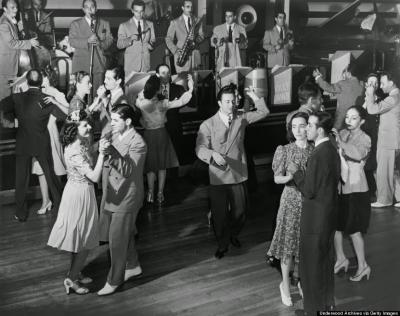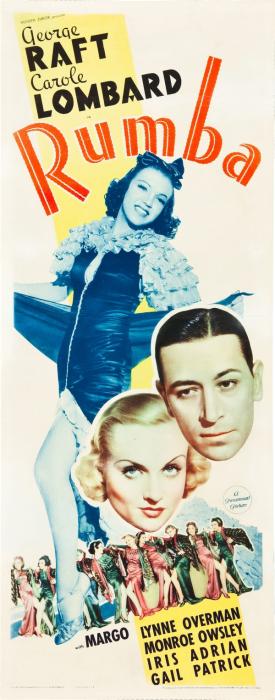- Historical Dance
- Jazz Age Social Dancing ("The Modern Dances")
- 0. The Essentials of Jazz Age Ballroom Dancing
- 1. Foxtrot Part 1: The Jazz Age Foxtrot
- 2. Youth Dancing in the Jazz Age
- 3. The Jazz Age Waltz
- 4. The Jazz Age Tango
- 5. 1930s Rumba
- 6. 1930s Samba
- 7. 1930s Conga
- 8. Bal Musette: Parisian Dance of the Jazz Age
- 9. Dancing in Weimar Berlin
- Dancing Made Easy - 1922
- Film Library - Jazz Age Dance
- Historical Dance Films posted to Pinterest
- Jazz Age Dance - Apologia
- Jazz Age Dance Image Collection
- Jazz Age Lead and Follow
- Places to Dance in Southern California in the Jazz Age
- Sampler of Jazz Age Dance Holds
- The Pathé Historical Dance Collection: 1920s-40s
- Ragtime Dance - the One Step
- Regency Dance
- Victorian Dance
- Jazz Age Social Dancing ("The Modern Dances")
5. 1930s Rumba
The 1930s saw the introduction of the Rumba (also spelled "Rhumba") to the North American and European ballroom. It was the result of applying a European ballroom dance vocabulary to a Latin beat. By around 1935, it was a full fledged dance craze - though it never reached the heights of popularity enjoyed by the Foxtrot.
When it first arrived on the scene, dancers applied familiar moves to a new beat. In the videos in this collection, there is a sophisticated group of dancers from 1930 using Tango/Foxtrot styling to a Rumba beat.
While the classic Rumba box-step was being demonstrated by dance teachers as early as 1930, it took a few years for a distinctive style of Rumba to emerge among the general dance population that was significantly different from the Tangos and Foxtrots that came before, and part of its appeal was probably that it was a departure from the settled norms of the 1930s ballroom. First of all, unlike the "just walking" dances that had predominated since the Turn of the Century, it had that specific step.
The second was the tendency of the partners to separate, and even when they were together they had an open frame and were seldom in the close embrace of the Foxtrot. Underarm turns were common, "throw outs" were a popular move and the dancers would even separate to do their own personal solo Rumbas before linking back up to their partners.
The Rumba also had an element of showmanship, of showing off, that had definitely not been part of mainstream Foxtrot-centered social dancing. Certainly Swing dancers were all about putting on a show, but Swing, with its popularity among African Americans and the white kids who emulated them, was seldom seen in the clubs and ballrooms of adult white "polite society".
All of this, along with intoxicating Latin rhythms provided a welcome bit of variety for the ballroom dancers of the '30s and '40s.
The Step
The Rumba is in 2/4 time and is played in a range of speeds from slow and sensuous to fast and ecstatic. The modern ballroom Rumba tends to be quite slow. In the '30s, it was usually played noticeably faster than is the current style.
Like the Waltz, it can be danced in a box-step.
 Here is the basic step, for the man (the woman, as always, does the opposite):
Here is the basic step, for the man (the woman, as always, does the opposite):
- Step forward with the left (slow 1-2)
- Step forward with the right (quick 3)
- Move the left next to the right (quick 4)
(This is all done with flexible knees and as much swaying of the hips as you can muster)
(Then reverse)
- Step back with the right (slow)
- Step back with the left (quick)
- Move the right next to the left (quick)
Congratulations, you're doing the Rumba.
The effect with the basic time step, as you will see in the videos, is a back-and-forth motion. However, once your feet have the rhythm then it's time to mix it up. In the videos you will see traveling steps, spins, underarm turns and any number of other variations. As with all the other dances of the time, the only time you are doing it wrong is when it breaks down. As long as it works, it's right.
The first video is a pastiche of clips from 1930s films showing popular Rumba variations. It begins with Martha Raye singing "What the Rumba Does to Romance" which makes fun of its tendency to separate the partners and take them out of the tender embrace of the Foxtrot. The pastiche also includes a brief clip, from a bit later, of George Raft demonstrating a more sedate close-hold variation of the Rumba. There's also a lot of a younger George, from the movie "Rumba", burning up the dance floor with the glamorous Carol Lombard.
After that, there's a wonderful clip from the '40s of Alice Faye and Cesar Romero doing an extended Rumba that is an excellent review of a lot of really useful ballroom variations.
The next is "proto-Rumba". Before the Rumba step was invented, people were doing a familiar Foxtrot/Tango to the Rumba beat.
Finally, there's a close hold Rumba.
The Proto-Rumba:
Before there was a Rumba step, people were dancing the old dances to the new beat.
Rumba in a sophisticated night club in 1930
These upscale stylish dancers are doing familiar Foxtrot and Tango moves to a Rumba beat.
Embedding is disabled, so you'll just have to click on the link.
Intimate Close Rumba
Here's a clip from the 1950s, with George Raft in a close Foxtrot hold, but with the familiar slow-quick-quick timing.

